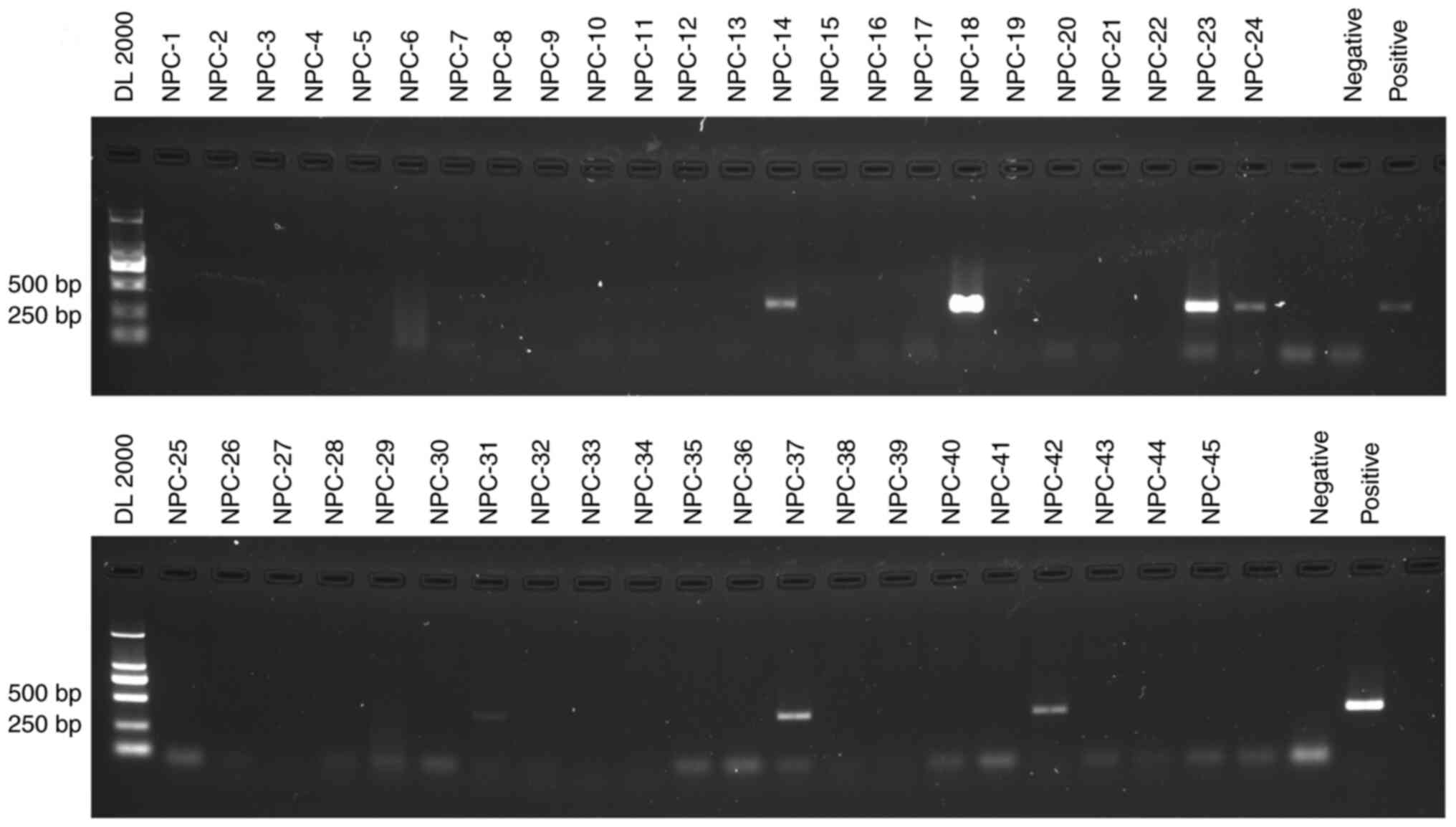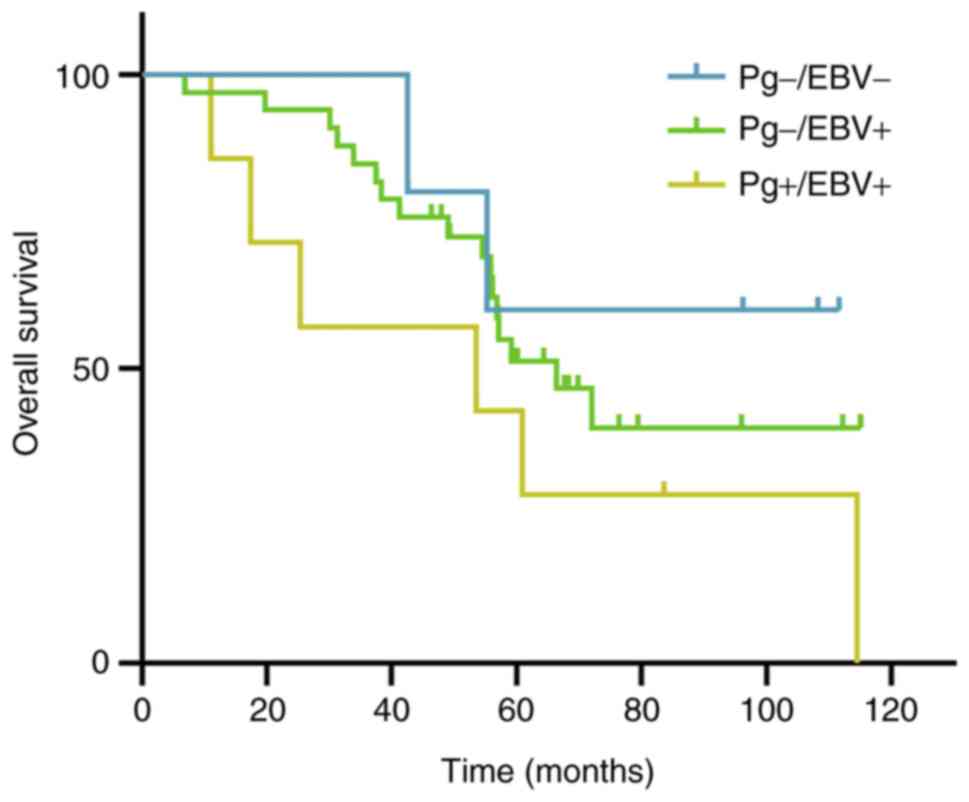|
1
|
Tsao SW, Yip YL, Tsang CM, Pang PS, Lau
VMY, Zhang G and Lo KW: Etiological factors of nasopharyngeal
carcinoma. Oral Oncol. 50:330–338. 2014.PubMed/NCBI View Article : Google Scholar
|
|
2
|
Chen W, Zheng R, Baade PD, Zhang S, Zeng
H, Bray F, Jemal A, Yu XQ and He J: Cancer statistics in China,
2015. CA Cancer J Clin. 66:115–132. 2016.PubMed/NCBI View Article : Google Scholar
|
|
3
|
Chen YP, Chan A, Le QT, Blanchard P, Sun Y
and Ma J: Nasopharyngeal carcinoma. Lancet. 394:64–80.
2019.PubMed/NCBI View Article : Google Scholar
|
|
4
|
Pihlstrom BL, Michalowicz BS and Johnson
NW: Periodontal diseases. Lancet. 366:1809–1820. 2005.PubMed/NCBI View Article : Google Scholar
|
|
5
|
Xu FH, Xiong D, Xu YF, Cao SM, Xue WQ, Qin
HD, Liu WS, Cao JY, Zhang Y, Feng QS, et al: An epidemiological and
molecular study of the relationship between smoking, risk of
nasopharyngeal carcinoma, and Epstein-Barr virus activation. J Natl
Cancer Inst. 104:1396–1410. 2012.PubMed/NCBI View Article : Google Scholar
|
|
6
|
Kato A, Imai K, Ochiai K and Ogata Y:
Prevalence and quantitative analysis of Epstein-Barr virus DNA and
Porphyromonas gingivalis associated with Japanese chronic
periodontitis patients. Clin Oral Investig. 19:1605–1610.
2015.PubMed/NCBI View Article : Google Scholar
|
|
7
|
Turkoz FP, Celenkoglu G, Dogu GG, Kalender
ME, Coskun U, Alkis N, Ozkan M, Turk HM and Arslan UY: Risk factors
of nasopharyngeal carcinoma in Turkey-an epidemiological survey of
the anatolian society of medical oncology. Asian Pac J Cancer Prev.
12:3017–3021. 2011.PubMed/NCBI
|
|
8
|
Hajishengallis G and Lamont RJ: Dancing
with the stars: How choreographed bacterial interactions dictate
nososymbiocity and give rise to keystone pathogens, accessory
pathogens, and pathobionts. Trends Microbiol. 24:477–489.
2016.PubMed/NCBI View Article : Google Scholar
|
|
9
|
Kato A, Imai K, Sato H and Ogata Y:
Prevalence of Epstein-Barr virus DNA and Porphyromonas gingivalis
in Japanese peri-implantitis patients. BMC Oral Health.
17(148)2017.PubMed/NCBI View Article : Google Scholar
|
|
10
|
Kato A, Imai K, Ochiai K and Ogata Y:
Higher prevalence of Epstein-Barr virus DNA in deeper periodontal
pockets of chronic periodontitis in Japanese patients. PLoS One.
8(e71990)2013.PubMed/NCBI View Article : Google Scholar
|
|
11
|
Yilmaz O, Watanabe K and Lamont RJ:
Involvement of integrins in fimbriae-mediated binding and invasion
by Porphyromonas gingivalis. Cell Microbiol. 4:305–314.
2002.PubMed/NCBI View Article : Google Scholar
|
|
12
|
Gao S, Li S, Ma Z, Liang S, Shan T, Zhang
M, Zhu X, Zhang P, Liu G, Zhou F, et al: Presence of Porphyromonas
gingivalis in esophagus and its association with the
clinicopathological characteristics and survival in patients with
esophageal cancer. Infect Agent Cancer. 11(3)2016.PubMed/NCBI View Article : Google Scholar
|
|
13
|
Dougherty WJ, Bae KS, Watkins BJ and
Baumgartner JC: Black-pigmented bacteria in coronal and apical
segments of infected root canals. J Endod. 24:356–358.
1998.PubMed/NCBI View Article : Google Scholar
|
|
14
|
Fouad AF, Barry J, Caimano M, Clawson M,
Zhu Q, Carver R, Hazlett K and Radolf JD: PCR-based identification
of bacteria associated with endodontic infections. J Clin
Microbiol. 40:3223–3231. 2002.PubMed/NCBI View Article : Google Scholar
|
|
15
|
Siqueira JF Jr, Rôças IN, Alves FR and
Santos KR: Selected endodontic pathogens in the apical third of
infected root canals: A molecular investigation. J Endod.
30:638–643. 2004.PubMed/NCBI View Article : Google Scholar
|
|
16
|
Lo KW, To KF and Huang DP: Focus on
nasopharyngeal carcinoma. Cancer Cell. 5:423–428. 2004.PubMed/NCBI View Article : Google Scholar
|
|
17
|
Slots J, Kamma JJ and Sugar C: The
herpesvirus-Porphyromonas gingivalis-periodontitis axis. J
Periodontal Res. 38:318–323. 2003.PubMed/NCBI View Article : Google Scholar
|
|
18
|
Könönen E, Syrjänen R, Takala A and
Jousimies-Somer H: . Nasopharyngeal carriage of anaerobes during
health and acute otitis media by two years of age. Diagn Microbiol
Infect Dis. 46:167–172. 2003.PubMed/NCBI View Article : Google Scholar
|
|
19
|
Bryant WS: The transition of the ciliated
epithelium of the nose into the squamous epithelium of the pharynx.
J Anat Physiol. 50:172–176. 1916.PubMed/NCBI
|
|
20
|
Kano M, Kondo S, Wakisaka N, Moriyama-Kita
M, Nakanishi Y, Endo K, Murono S, Nakamura H and Yoshizaki T: The
influence of human papillomavirus on nasopharyngeal carcinoma in
Japan. Auris Nasus Larynx. 44:327–332. 2017.PubMed/NCBI View Article : Google Scholar
|
|
21
|
Mohammed H, Varoni EM, Cochis A, Cordaro
M, Gallenzi P, Patini R, Staderini E, Lajolo C, Rimondini L and
Rocchetti V: Oral dysbiosis in pancreatic cancer and liver
cirrhosis: A review of the literature. Biomedicines.
6(115)2018.PubMed/NCBI View Article : Google Scholar
|
|
22
|
Haraldsson G, Holbrook WP and Könönen E:
Clonal similarity of salivary and nasopharyngeal Fusobacterium
nucleatum in infants with acute otitis media experience. J Med
Microbiol. 53:161–165. 2004.PubMed/NCBI View Article : Google Scholar
|
|
23
|
Atanasova KR and Yilmaz O: Looking in the
Porphyromonas gingivalis cabinet of curiosities: The microbium, the
host and cancer association. Mol Oral Microbiol. 29:55–66.
2014.PubMed/NCBI View Article : Google Scholar
|
|
24
|
Olsen I and Yilmaz Ö: Possible role of
Porphyromonas gingivalis in orodigestive cancers. J Oral Microbiol.
11(1563410)2019.PubMed/NCBI View Article : Google Scholar
|
|
25
|
Irfan M, Delgado RZR and Frias-Lopez J:
The oral microbiome and cancer. Front Immunol.
11(591088)2020.PubMed/NCBI View Article : Google Scholar
|
|
26
|
Geng F, Liu J, Guo Y, Li C, Wang H, Wang
H, Zhao H and Pan Y: Persistent exposure to Porphyromonas
gingivalis promotes proliferative and invasion capabilities, and
tumorigenic properties of human immortalized oral epithelial cells.
Front Cell Infect Microbiol. 7(57)2017.PubMed/NCBI View Article : Google Scholar
|
|
27
|
Imai K, Inoue H, Tamura M, Cueno ME, Inoue
H, Takeichi O, Kusama K, Saito I and Ochiai K: The periodontal
pathogen Porphyromonas gingivalis induces the Epstein-Barr virus
lytic switch transactivator ZEBRA by histone modification.
Biochimie. 94:839–846. 2012.PubMed/NCBI View Article : Google Scholar
|
|
28
|
Makino K, Takeichi O, Imai K, Inoue H,
Hatori K, Himi K, Saito I, Ochiai K and Ogiso B: Porphyromonas
endodontalis reactivates latent Epstein-Barr virus. Int Endod J.
51:1410–1419. 2018.PubMed/NCBI View Article : Google Scholar
|
|
29
|
Ke K, Wang H, Fu S, Zhang Z, Duan L, Liu D
and Ye J: Epstein-barr virus-encoded RNAs as a survival predictor
in nasopharyngeal carcinoma. Chin Med J (Engl). 127:294–299.
2014.PubMed/NCBI
|

















